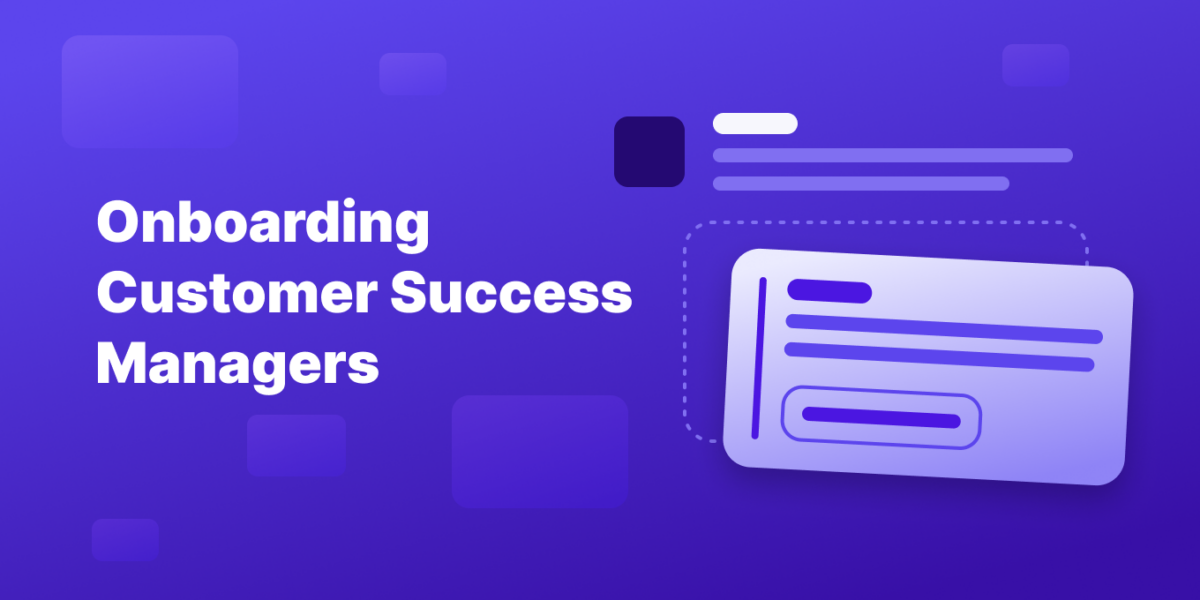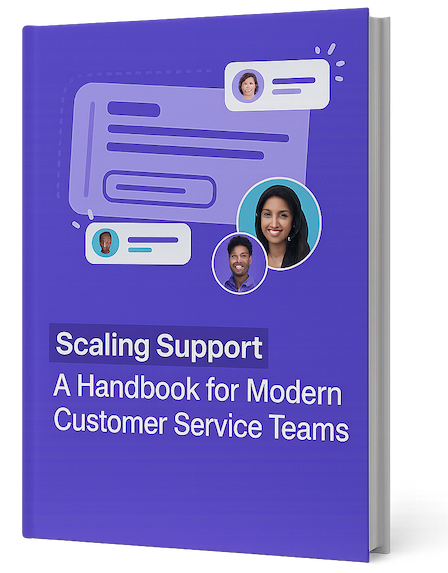You’ve just hired another customer success manager and are excited about growing your team.
This new hire to the customer success team can potentially increase customer satisfaction and drive business growth.
However, to fully capitalize on this opportunity, your process for onboarding customer success managers must be thorough and strategic.
Effective onboarding involves more than equipping CSMs with knowledge, tools, and resources. It also involves fostering a sense of belonging and driving alignment with business objectives and company culture.
A good customer experience is not possible without a good employee experience. And a good employee experience starts with a well-thought-out onboarding plan.
So, the question is: How do you effectively onboard customer success managers?
We’ll answer that question and more in this article.
The importance of effectively onboarding customer success managers
CSMs that go through a proper onboarding process positively impact the customer experience. Here’s why.
Enhance the customer experience
Skipping or rushing the onboarding process signals to customers that your team is not prepared or equipped to help them, which can damage your company’s brand.
On the other hand, a well-trained customer success team shows customers you truly care, which helps build trust with your brand and grows customer lifetime value (CLTV) and expansion revenue.
Improve employee retention
Employees want to feel welcomed, valued, and confident in their roles. A good onboarding process indicates that you care about your employees, and it helps them approach each workday more confidently. Onboarding should give the CSM clear expectations so they know what to work on and how to do it. This leads to a more motivating and engaging work environment.
Align business goals
Onboarding helps CSMs understand the company’s business objectives, and a good onboarding plan should align daily activities with those goals. With a clear understanding of the company’s vision, customer success managers can make their work more impactful and relevant to the company’s goals.
Build stronger employee relationships
A comprehensive onboarding process includes training on internal processes and tools, often involving roles outside of customer success.
Introducing cross-team collaboration helps build stronger relationships and improves the overall company culture. After all, effective teamwork is essential for addressing complex issues and advocating for customers.
Increase new hire confidence
A customer success onboarding program should enable new CSMs to gain the skills and knowledge they need to interact with customers and handle various challenges with confidence.
This increased competence results in higher customer satisfaction, as CSMs are more prepared to handle customer needs and help them achieve their desired outcomes. The more confident your CSMs are, the more driven they will be to help customers succeed.
Accelerate time to proficiency
Effective onboarding helps CSMs quickly understand the company’s culture, products, and customer needs. This enables new hires to make more meaningful contributions sooner and drive value within the customer success team.
The goals of onboarding customer success managers
Onboarding looks different from company to company, but it generally aims to give employees the tools, resources, and information they need to do their jobs.
Onboarding should accomplish the following things:
- Establish a clear understanding of roles: Unclear roles lead to confusion, wasted effort, and internal and external frustration. Avoid this pitfall by being super clear on each person’s role and scope of work. Once a CSM is onboarded, they should know who to go to for what and where their responsibilities lie, and that starts with understanding everyone’s roles and scope of work.
- Educate on systems and processes: Every business relies on tools and technology and a variety of different processes. Sharing customer feedback, updating internal docs, taking notes on a call, planning a QBR, and tracking customer onboarding all require tools and processes, and it’s critical that you take time to get new CMSs familiar with how you work so they can hit the ground running.
- Map out the customer journey: Customer success managers must be able to imagine themselves in the customers’ shoes. A customer journey map is a great way to understand the customer’s perspective and identify pain points. Every role in customer support and success should familiarize themselves with the customer journey.
- Align on business goals: Onboarding is a great time to communicate business objectives to CSMs. This helps ensure they focus on the right areas of the product or service and align their work with the business’s priorities and objectives.
- Drive product understanding: A CSM should have a solid understanding of your product or service. Depending on the complexity of your business, this could be a small or significant portion of the onboarding plan. Note: Extensive training might be required, depending on the product’s technicality.
- Instill company culture and values: Company values aren’t just abstract concepts. They shape the workplace environment, employee behavior, customer interactions, and overall business success. They are your company’s foundation, and it’s vital to build a culture where employees are driven to live your company’s values daily.
Tips for onboarding customer success managers
Structured onboarding is a standard process that helps new hires transition into their roles and become more productive and impactful employees. It also helps build stronger and more motivated teams in an efficient and scalable way.
Building a structured onboarding program takes time and ongoing maintenance, but it can ultimately impact your bottom line by strengthening your business and helping you attract more talent and business. Here are seven tips for onboarding customer success managers.
Set clear objectives and expectations.
Define your goals for the onboarding plan and make it super clear what you expect the new hire to learn by certain points of time. The onboarding program should be relevant to the employee’s role and align with the overall business objectives.
Example: Once onboarding is complete, as a CSM, you should be able to successfully demo the product and field tier 1 and 2 support tickets.
Create an onboarding roadmap.
Many companies use a 30-day or 90-day plan, with each week mapped out.
The onboarding plan should act as a roadmap for new employees so they can adequately navigate their first several weeks.
Example: Create a document (or use a knowledge management tool, like Tettra,) to hold all training resources and schedule out tasks for the new hire. Each week should be clearly laid out, and they should know exactly what they need to accomplish by the end of it.
Create role-specific training modules
Customer success roles vary from individual contributor, manager, CS Operations, CS Engineering, and more.
Onboarding shouldn’t be a one-size-fits-all approach, each role is unique and therefore requires it’s own special training modules. Because there is so much context and material needed, many companies choose to use a knowledge management solution, like Tettra, to host all of this material in an easily accessible manner.
Make sure the training modules are relevant for each new hire so you utilize their time in the best way possible.
Example: A renewals manager won’t need the same training as customer success operations. While there will certainly be some overlap, CS ops will be much more in the weeds administering systems and tools.
Use onboarding tools effectively
Your company might already have onboarding tools you can use to map out the customer success onboarding plan. These tools are great because they make onboarding repeatable and scalable. If you don’t have a dedicated onboarding tool, you can use Google Docs or something similar to create your own onboarding template.
Example: A company wiki like Tettra is a great place to document your onboarding process. You might also leverage a Learning Management System (LMS).
Offer mentorship and encourage peer support
Connecting new hires with more tenured employees is a great way to expedite the learning path. It’s also an excellent opportunity for new hires to build relationships with existing employees.
Example: As part of the onboarding process, have new CSMs participate in 10 phone calls with customers. This will give them a sense of common questions and steer them in the right direction for talking about the product.
Evaluate and seek feedback
As onboarding progresses, evaluate progress and give the CSM regular feedback. New employees are more prone to feeling anxious about whether or not they’re hitting the mark or not. The more you engage with them, the more they will feel valued, and you can also address anything that needs to be corrected. On the other hand, you should also seek feedback from employees to learn how you can improve the onboarding process.
Example: Regular check-ins with your manager can be a great way to solicit this feedback as well as coach new CSMs.
Conduct ongoing maintenance
As your business evolves, your onboarding plan will need to be updated. Products and services change over time, processes get updated, and some things just become completely irrelevant. Onboarding takes valuable time, so you need to use it wisely. You don’t want new CSMs wasting time learning about parts of the business that no longer exist.
Using an internal knowledge base to house your documented onboarding plan helps a lot with this.
For example, Tettra’s knowledge management features systematically surfaces knowledge for regular verification. It can also automatically identify knowledge gaps so that you’re not just maintaining your onboarding plan — you’re regularly improving it, instead.
Example: Review the onboarding plan before sending it to a new CSM. Additionally, encourage new hires to provide feedback on the plan so they can point out areas that might need updating.
The vital role of onboarding in customer success management
Hiring is a significant investment, and it shouldn’t stop at the offer letter. Customer success managers must undergo a thorough onboarding program to be impactful in their roles.
Skipping onboarding or approaching it flippantly will only hurt your customers and your business. So, take time to develop a solid onboarding plan before you hire customer success managers.
More info about customer service from Tettra
- How to empower customer service
- Top customer service metrics to track
- 17 most common customer service titles
- Customer service tips for a successful business
- Best customer service tools and software
- How customer service teams can use Tettra
How Tettra helps your customer support and customer service teams
With Tettra, you can:
- Get instant answers from a purpose-built AI, using your company documentation as a base.
- Use a ready-made Q&A workflow, enabling your team to ask questions to the larger team and get answers from the most reliable sources.
- Rely on a world-class knowledge base tool to store your documentation
- Leverage knowledge management features to keep your content up to date
Here’s more on how Tettra helps customer support teams specifically.
You can start a free trial today to see how Tettra makes it easier for you to capture and share your customer support workflows.


